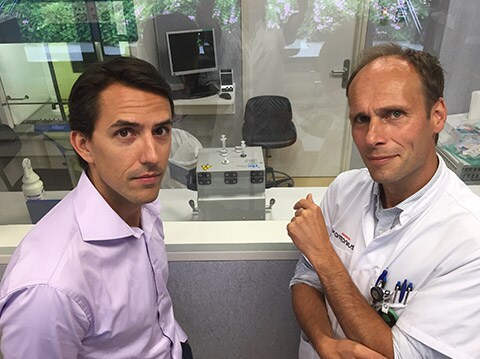A large part of the promise of molecular imaging is in the development of new, more specific tracers – going beyond the standard PET scans into non-FDG applications. The St. Antonius hospital in Nieuwegein, the Netherlands, is the first Dutch hospital to start using a Gallium-68-labeled radioligand for prostate-specific membrane antigen (Ga68PSMA) to detect recurrence of prostate cancer. And they’re not stopping there: the St. Antonius radiopharmacists are investing in other applications of their gallium generator, and in bringing expanded capabilities to other hospitals.
We are very proud of our Ga68PSMA PET, and we believe this is a large step forward in prostate cancer imaging."
Expanding hospital capabilities to enhance diagnostics
Ga68PSMA PET has been shown to be able to pinpoint prostate cancer cells with a high level of accuracy and specificity. However, it is labeled with 68-Gallium instead of the much more common 18-Fluorine. Because the half-life of Gallium-68 is only 68 minutes, the St. Antonius hospital chose to start generating the radioisotope in-house. “We are very proud of our Ga68PSMA PET, and we believe this is a large step forward in prostate cancer imaging,” says Dr. Jules Lavalaye, nuclear medicine physician at the St. Antonius. “The images are overwhelming in clarity, detecting metastases at a very early stage. We are convinced that Ga68PSMA PET will profoundly change diagnostics in prostate cancer, and improve patient outcome.” To acquire this capability, the hospital incorporated a gallium generator and set up an entirely new labeling procedure in the nuclear medicine department. A Philips PET/CT system is used to acquire the Ga68PSMA PET images. “It was not easy to introduce the gallium generator and labeling procedure into the department,” says Lavalaye, “and it is good to emphasize the effort and investment it takes. Good cooperation with the radiopharmacists and medical physicists was essential in this. The revenue, however, is high.”

The St. Antonius hospital in Nieuwegein, the Netherlands.
Creating opportunities for other hospitals
At this time, Ga68PSMA-ligand is only used for men who have increased PSA values after prostate cancer treatment, as it facilitates earlier detection of recurrence and of metastases. The gallium generator is not sitting idle, though. The St. Antonius has also adopted Gallium-68-labeled tracers for detecting neuroendocrine tumors and is working hard to bring Gallium-68 into the clinical mainstream. For many hospitals, the high equipment investment needed is a big barrier to adopting Gallium-68 for routine use. You need hot cells and a synthesis module, and gas chromatography, high-performance liquid chromatography and atomic absorption spectrometry for quality control. To bring the promising clinical applications of Gallium-68 to more hospitals, St. Antonius pharmacists recently published a method for preparing Gallium-68-DOTA-NOC in a way that is compliant with quality regulations but does not require any of the instruments mentioned above.

Roeland Vis, pharmacist at the St. Antonius, (left) and Jules Lavalaye (right). The 68Ge/68Ga generator in the radionuclide laboratory (center) is shielded inside.
Having the eyes to see
The increasing variety of isotopes and radiopharmaceuticals in use has great potential, especially when hospitals such as the St. Antonius are establishing methods that may help lower the barriers to adoption of Gallium-68. Besides 18F and Gallium-68, other isotopes are available as well. That’s why there are also some interesting advancements in PET/CT technology that enable hospitals to be prepared for future challenges. Beyond the time-of-flight (TOF) technology that is now standard on Philips PET/CT scanners, Philips is also breaking new ground with quantification tools such as xPand5 which includes reconstruction with even smaller voxels, and the Philips Vereos, the first truly digital PET/CT for the entire spectrum of applications.

Ga68PSMa PET in a patient with recurrent prostate cancer. At the arrowhead: a lymph node metastasis. Acquisition parameters: 3 min/bed position on the Gemini 64 ToF, 60 min after injection of 2 MBq/kg of Ga68PSMA. Images courtesy of the St. Antonius hospital, Nieuwegein, the Netherlands.
Although Gallium-68 is not a particularly challenging isotope to image, clinicians at the St. Antonius are happy with their Philips PET/CT scanner with TOF. It was very easy to set up for the new isotope, and the TOF functionality makes the high contrast of Gallium-68-labeled tracers even more striking. Lavalaye: “We have shown that Ga68PSMA is so sensitive, that it can show lymph node metastases in nodes of 5 mm and smaller, therefore camera resolution is crucial for Ga68PSMA PET imaging. For small metastases centrally in the abdomen, especially in obese patients, the time-of-flight technique is really rewarding.”

Ga68PSMA PET scan of a patient with prostate cancer and one solitary bone metastasis in the sacrum. Acquisition parameters: 3 min/bed position on the Gemini 64 ToF, 60 min after injection of 2 MBq/kg of Ga68PSMA. Images courtesy of the St. Antonius hospital, Nieuwegein, the Netherlands.
For more information
You can read more about the GMP-compliant radiolabeling method the St. Antonius developed in the following article:
Vis R, Lavalaye J, van de Garde EM. GMP-compliant (68)Ga radiolabelling in a conventional small-scale radiopharmacy: a feasible approach for routine clinical use. EJNMMI Res. 2015 Apr 24;5:27
For more information about the latest Philips developments in PET/CT and TOF, please visit the following pages:
